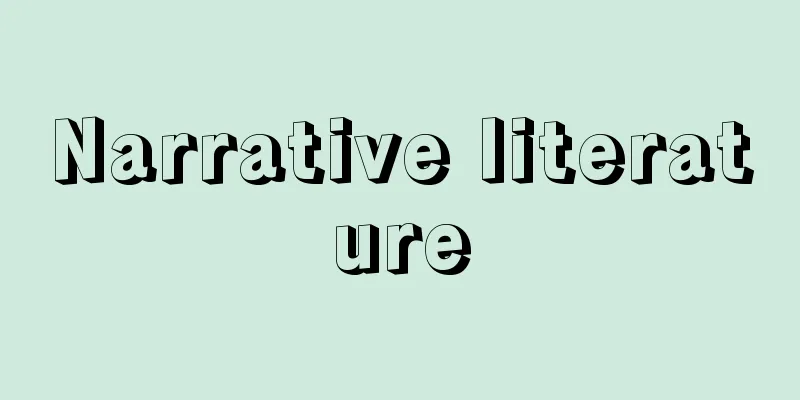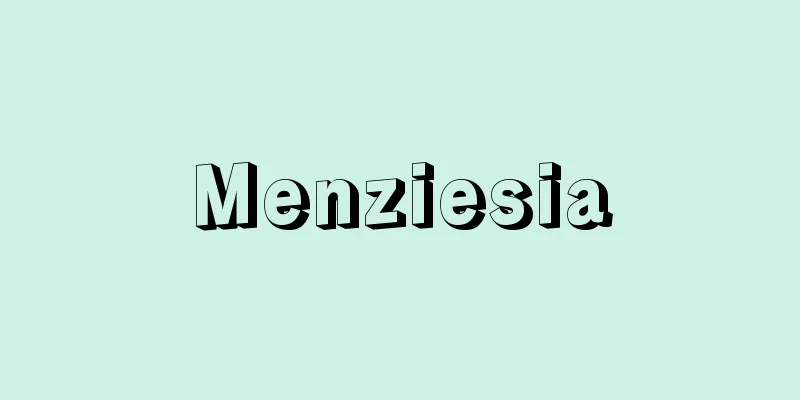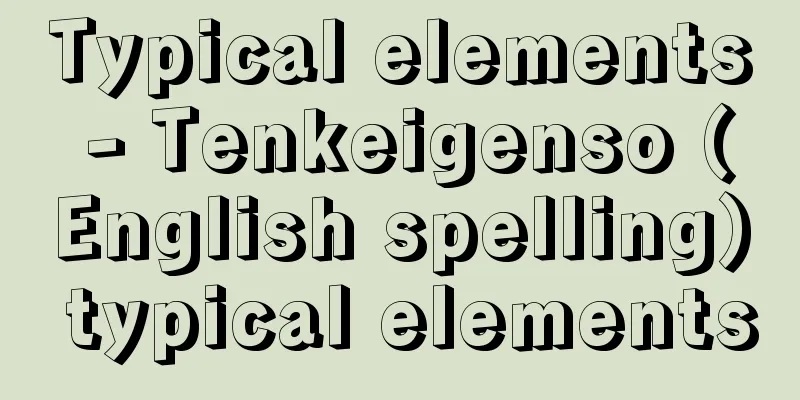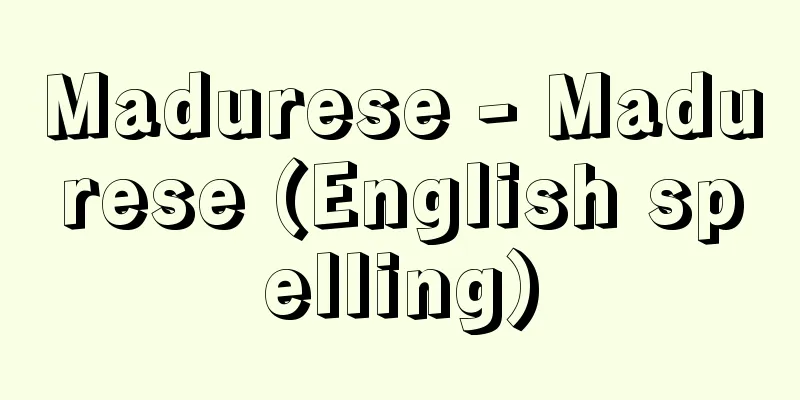Narrative literature

|
A name given to tales written down in text, focusing on their literary quality. This term is used especially in the history of ancient and medieval Japanese literature to contrast with "waka literature" and "narrative literature." As can be seen from the title of "Konjaku Monogatarishu" (Tales of Times Now Past and Present), individual tales were once considered a type of "tale," but collections of tales that were collected and compiled gave a different impression from normal stories, so they were often treated as miscellaneous books or collections of miscellaneous stories, and Buddhist tales were often included in Buddhist books. The terms "tales" and "narrative literature" were created in the world of Japanese literature during the Taisho period, and have been used frequently ever since. However, it cannot be denied that they tend to be used conveniently as academic terms without strict conceptual definitions, and the scope is not necessarily fixed, but literary tales and collections of them are relatively loosely included in this category. [Norihito Miki] kindsIn the case of literature from the Middle Ages and the Middle Ages, it is customary to divide them into two major categories: general (secular) tales and Buddhist (divine and Buddhist) tales, but the former are classified and named in various ways, such as aristocratic tales and commoner tales based on their foundation, and the latter are classified in various ways, such as tales of awakening to solitude, tales of going to the afterlife, and miraculous tales, based on their subject matter and theme. There are also tale collections that show an encyclopedic range of topics, and tales overwhelm other genres in their variety. [Norihito Miki] Format and CharacteristicsIn contrast to the diversity of content, the format of the tales is relatively uniform, with the basic steps being to first introduce the time, place, and characters, trace the course of events, and add impressions or critical phrases as necessary. The sentences often end with "keri," and sometimes begin with phrases like "mukashi" (olden days) or "ima wa mukashi" (now old days). Generally, they are short stories, lacking in narrative flourishes and psychological analysis, and characterized by their narrative nature. As a result, the descriptions tend to be simple and clear, and in extreme cases, some are merely a single sentence that simply states the gist of a fact. They are written down as they have been told since ancient times, or as heard from others, and lack individual creativity, but there are also tale collections in which the author's attitude and inclinations are apparent in the way the tales are selected, arranged, and given meaning, and as a whole, each work is unique. The unique appeal of narrative literature lies in the dexterity with which it uses small spaces to create dramatic scenes, the sharp criticism of life that it expresses within them, and its flexibility and inclusiveness, allowing it to reach out in many directions to include worlds that other genres do not address. [Norihito Miki] Literary historyThe ancient literature of the Kojiki and the Fudoki actively incorporate tales, and the Manyoshu also has many parts with a tale-like world as its background. However, the oldest complete collection of tales is the Nihon Ryōiki (completed around 823) by the Yakushiji monk Keikai. Other works include the Yamato Monogatari, which can be called a collection of waka tales, the Sanbōe Kotoba (Sanbo Ekotoba) (by Minamoto no Tamenori), a Buddhist commentary that makes extensive use of tales, and the Nihon Ojo Gokurakuki (Japanese Ojo Gokurakuki) (by Yoshishige no Yasutane), which is a lineage of tales about the afterlife. The flow of tale literature can be seen in works up to the mid-Heian period, but it was during the Insei period that it began to show its vitality. That is, the unprecedented work "Konjaku Monogatarishu" (whose work was probably created shortly after 1120) was published before and after it, along with "Kohon Setsuwashu" and "Uchigikishu", and "Godansho", "Chugaisho", and "Fukegodan", which recorded the conversations of upper-class aristocrats, were published one after another. The historical tale "Ookagami", the poetry treatise "Shunpisho" (Toshiyori Zuinou) and "Fukurozoshi" all made extensive use of tales, and this tendency was continued in later generations. The popularity of storytelling was probably rooted in the sense of crisis felt by people living in the transitional period from ancient times to the Middle Ages. People who were reexamining tradition and turning their eyes to another world to find guidance in life sought storytelling as a source of information, and appreciating the fresh appeal of storytelling must have been an invaluable pleasure for them. Thus, a great number of storytelling collections were written during the Kamakura period. General storytelling collections include "Kojidan," "Zoku Kojidan," "Uji Shui Monogatari," "Ima Monogatari," "Jikkinsho," and "Kokonchomonju," which tell unusual stories from ancient and modern times, both in the capital and the countryside, in a lively way, and show brilliant portrayals of human beings. In addition, there are collections of Buddhist tales such as "Hobutsushu," "Hosshinshu," "Kankyonotomo," "Senjusho," "Shijuhyakuinnenshu," "Shasekishu," and "Zotansyu," which convey the propagation of old and new Buddhism, and the search for a new world for ascetics. In addition, there are collections of Chinese stories such as "Karamonogatari," "Mongyuwaka," and "Tangkyo," as well as legends of temples and shrines that are similar to collections of Buddhist tales, and war tales such as "The Tale of the Heike" also form an essential element of tales. However, in the Nanboku-cho and Muromachi periods, although tales continued to spread and infiltrate other genres, tale collections became less common, with only sporadic appearances of works such as "Shintoshu," "Yoshinoshui," and "Sankokudenki." Even in the early modern period, many tales were written in essays, and there were many books that collected strange tales and ghost stories, but narrative literature was only spoken of as something that provided material and inspiration for novels. [Norihito Miki] EuropeIf we consider the Japanese "Konjaku Monogatarishu" as a typical example of narrative literature, European narrative literature is not necessarily written in prose. Even if the content is the same, there are many stories written in verse in ancient and medieval Western literature. Myths, legends, miracles, strange tales, grotesque, erotic, historical events, and customs are also often written in verse. Hesiod's "Theogony" and "Works and Days," the prototype of the peasant calendar, are also written in poetic form. Ovid's "Metamorphoses," a major work in ancient narrative literature, and Apuleius' "Metamorphoses" (also known as "The Golden Ass") were both written in the form of poetry, and the ancient legends of the Celts also contain many stories written in the form of poetry, such as Marie de France's "Lais." The typical type of narrative literature in medieval France (12th to 13th centuries) is the "fabliaux." These are short humorous verses, usually written in a stream of eight-syllable verse. In terms of content, they are the medieval prototype of secular literature, and the themes, narrative style, and plots are all very similar to those in the Honcho-hen section of the Japanese "Konjaku Monogatarishu." They are good materials for comparative literature research, and about 150 remain. In the 14th century, these took on theatrical form and became "farce," which led to Italian comedy and then to the full-scale comedy of the 17th century, the plays of Molière. On the other hand, the "Fabriaux" entered Italy in the early Renaissance and provided material for Boccaccio's "Decameron," supplying many themes for the humanistic thought of the Italian Renaissance and paving the way for 100 pieces of highly artistic literature. This also shows the process of exchange that gave birth to masterpieces of French narrative literature in the 15th century, such as "The 15 Joys of Marriage" and "Le Saint Nouvelle Nouvelle." A little earlier, in the second half of the 14th century, Chaucer, the first great poet of English literature, emerged and wrote "The Canterbury Tales" following in the footsteps of Boccaccio. This is a collection of 24 stories, and is in the form of "The Decameron," in which pilgrims on a pilgrimage to Canterbury tell their stories, but 21 of the stories, including the prologue, are in the form of poetry, making it a masterpiece of European-style narrative literature. Narrative literary works continued until around the 18th century, when the name was changed to conte (French), nouvelle (French), novel (English), etc. In France, it constituted a major genre of prose literature, from the emergence of masters such as Voltaire in the 18th century to Mérimée and Maupassant in the 19th century. [Teruo Sato] IndiaIndia is a treasure trove of tales, and Indian tales were once proudly called the origin of world narrative literature, with many variations found all over the world, and their content as well as their form having had a major influence on tales from other countries. When it comes to the transmission of Indian tales, some tales are transformed by the customs, habits, and religion of the place they are handed down, and are so different from their original form that they seem to be tales unique to that country. There are also cases where entire collections of tales have been handed down in a collected form, such as the Panchatantra and the Śukasaptati (Seventy Tales of the Parrot). However, the format of including many tales in a frame story, as seen in the Arabian Nights and the Decameron, seems to have originated in India. Indian tales have ancient origins, and ancient and elegant tales can be found in the Brahmanic literature, and the two great epics, the Mahabharata and the Ramayana, contain many tales as well as mythological legends. It is not clear when tales began to be compiled into a single collection, but with the creation of the Buddhist tales of the Jatakas (Tales of the Original Life), thought to have been compiled around the time of the birth of the Christian era, the great tales of the Brihatkatha, which no longer exists, and the Panchatantra, the original of which has been lost, narrative literature developed greatly, and many tales of various sizes were created, ranging from moral fables and fairy tales to popular tales for entertainment purposes. Indian narrative literature occupies an important place in the history of world literature, and the spread of the Panchatantra in particular is remarkable, having been translated and circulated in over fifty languages in both the East and the West. The original Panchatantra was lost and has been passed down through several copies, but around the 6th century, one of these copies was translated into Pahlavi, a medieval Persian language, and then into Syriac and Arabic, where it spread to Western countries under the name Kalila and Dimna, and also spread to Southeast Asian countries, exerting a great influence on narrative literature in both the East and the West. The original Brihatkatha by Gunadiya was also lost, but it was widely disseminated through several adaptations, including the Katasaritsagara by Somadeva (11th century). The Jataka, a collection of 547 stories about the Buddha's past life, was written in Pali and is a compilation of folk tales from around the time of Christ, reworked for the purpose of spreading Buddhism, and was also spread in China and Japan. Other collections of stories intended for entertainment include the Betarapanchavinshatika (25 Tales of the Dead Ghosts) and the Shukasaptati, and due to their popular content, they have been passed down not only in India but also in Mongolia and Southeast Asian countries. [Tanaka Otoya] Narrative Literature and Picture Scrolls by Masuda Katsumi (1960, San'ichi Shobo) ▽ A Theory of Medieval Narrative Literature by Nishio Koichi (1963, Hanawa Shobo) ▽ Japanese Tales, eight volumes (1973-1975, Tokyo Bijutsu) ▽ Folk Tales, volumes 1 and 2 by S. Thompson, translated by Araki Hiroyuki and Ishihara Suiyo (Shakai Shisosha, Gendai Kyoyo Bunko) ▽ A Theory of Folk Tales by G. Yue, supervised by Seki Keigo, translated by Ishikawa Toshio (1981, Dohosha Publishing) ▽ Folk Tales by Seki Keigo (Iwanami Shinsho) [References] | | | | | | | | | | | | |Old type edition, Volume 1, published during the Keicho and Genna eras (1596-1624), some revisions, held at the National Diet Library "The Great Mirror" "Shrine and Temple" compiled by Minamoto no Akikane, manuscript with notes, held at the National Diet Library "Ancient Tales" Volume 1 "Shintoism First" Edited by Tachibana Shigeki Manuscript held at the National Diet Library "> "Kokin Chomonshu" Old type version, Volume 1, published during the Genna period (1615-1624), owned by the National Diet Library "Senshu-sho" Old print version No. 1 Written by Muju Published in 1618 (Genwa 4) Collection of the National Diet Library "Shasekishu" Source: Shogakukan Encyclopedia Nipponica About Encyclopedia Nipponica Information | Legend |
|
文章として記載された説話を、その文学性に着目してよぶ称。とくに日本の古代・中世文学史で、「和歌文学」「物語文学」などに対比されるものに、この語を用いる。個々の説話は、『今昔物語集』などの題からもわかるように、古くは「物語」の一種と考えられたが、それらを収集・編纂(へんさん)した説話集は通常の物語とは別の印象を与えるので、雑書・雑抄扱いにされたり、仏教的なものは仏書のなかに含まれることが多かった。「説話」ないし「説話文学」の語が生まれたのは大正期の国文学の世界においてであって、以後多用されるようになった。ただし、学術用語として厳密な概念規定なしに便宜的に使われている傾向は否めず、その範囲はかならずしも一定しないが、説話のうちで文学的なもの、また、それを収録したものを比較的緩やかにこの領域のなかに入れている。 [三木紀人] 種類中古・中世文学の場合、一般(世俗)説話と仏教(神仏)説話に二大別する習わしだが、前者は基盤に即して貴族説話と庶民説話、後者は素材、主題に即して発心遁世(ほっしんとんせい)談、往生(おうじょう)談、霊験談等々とされるなど、さまざまな分類、命名が行われている。百科事典的な話題の広がりをみせる説話集もあり、説話は多彩さにおいて他の諸ジャンルを圧倒する。 [三木紀人] 形式と特性内容の多彩さに比べ、説話の形式は比較的千編一律で、まず時、場所、登場人物などを紹介、できごとの経緯をたどり、必要に応じて感想、批評の辞句を添えるというのが基本的な手順になっている。文末には多く「けり」が用いられ、ときには冒頭に「昔」「今は昔」の類を冠する。概して短編で、物語のような文飾や心理分析に乏しく、叙事性を特徴とする。したがって、描写は単純明快な傾向が目だち、極端な場合には、ある事実の骨子をそのまま述べた一文にすぎないものもある。古来語られてきたままを、また、他からの伝聞によるままを伝承して記し、個人による創作性に乏しいが、説話の選別、整序、意味づけなどの仕方に作者としての姿勢や志向を示す説話集もみられ、作品全体としてはそれぞれ独自なものに富む。説話文学固有の魅力は、ささやかな余白を用いて劇的な場面を映し出す手さばきの鮮やかさ、そのなかに示す人生批評の鋭さ、他のジャンルが取り上げない世界をも含めて触手を多方向に及ぼす自在さ、包容力などにあろう。 [三木紀人] 文学史的展開上代文学の記紀、『風土記(ふどき)』は説話を積極的に組み込んでおり、『万葉集』にも説話的世界を背景にもつ部分が少なくない。しかし、まとまった説話集として最古のものは、薬師寺の僧景戒(けいかい)の『日本霊異記(にほんりょういき)』(823前後成立)である。以下、和歌説話集とも称しうる『大和(やまと)物語』や、説話を多用した仏教解説書『三宝絵詞(さんぼうえことば)』(源為憲(ためのり))、『日本往生極楽記』(慶滋保胤(よししげのやすたね))に始まる往生伝の系譜などもあり、平安中期までの作品に説話文学の流れをみることができるが、それが活気をみせ始めるのは院政期のことである。すなわち、質量ともに空前の作品である『今昔物語集』(1120以後まもなく成立か)、その前後に『古本(こほん)説話集』『打聞集(うちぎきしゅう)』などがあり、上流貴族の談を記録する『江談抄(ごうだんしょう)』『中外抄』『富家語談(ふけごだん)』が相次いで登場した。歴史物語『大鏡(おおかがみ)』、歌論『俊秘抄(しゅんぴしょう)(俊頼髄脳(としよりずいのう))』『袋草紙(ふくろぞうし)』などに説話の多用がみられ、この傾向は後世にも受け継がれた。 説話の盛行は、古代から中世への転換期を生きる人々の危機意識に根ざしたものであろう。伝統を見直し、別世界に目を向けて生の指針を知ろうとする人々が、情報としての説話を求めたのであり、説話の新鮮な魅力を味わうことは彼らにとって得がたい楽しみともなったはずである。こうして、鎌倉期にはおびただしい説話集が書かれることになる。一般説話集として、『古事談』『続古事談』『宇治拾遺(うじしゅうい)物語』『今(いま)物語』『十訓抄(じっきんしょう)』『古今著聞集(ここんちょもんじゅう)』があり、古今都鄙(とひ)の珍しい話題を小気味よい切り口で語って人間描写に冴(さ)えをみせた。また、仏教説話集に、『宝物集(ほうぶつしゅう)』『発心集(ほっしんしゅう)』『閑居友(かんきょのとも)』『撰集抄(せんじゅうしょう)』『私聚百因縁集(しじゅひゃくいんねんしゅう)』『沙石集(しゃせきしゅう)』『雑談集(ぞうたんしゅう)』などがあり、新旧諸仏教の布教や、遁世者の模索の跡を伝えている。このほか、中国の話を集めた『唐(から)物語』『蒙求和歌(もうぎゅうわか)』『唐鏡』、仏教説話集に準ずる寺社の縁起(えんぎ)類もあり、『平家物語』など軍記物語も説話を不可欠の要素としている。しかし、南北朝・室町期になると、他ジャンルへの説話の進出、浸透はなおみられるものの、説話集という形をとるものは少なくなり、わずかに『神道集(しんとうしゅう)』『吉野拾遺(よしのしゅうい)』『三国伝記』などが散発的に現れた程度である。近世以降も随筆のなかに説話が多く書かれ、奇談、怪談などを集成した書物も多いが、説話文学は小説に素材や刺激を与えたものとして語られるにとどまっている。 [三木紀人] ヨーロッパ日本の『今昔物語集』を典型的な説話文学と考えるなら、ヨーロッパの説話文学はかならずしもつねに散文形式をとってはいない。内容的には同じ説話であっても、西欧の古代・中世の文学のなかには韻文で書かれたものが多々ある。神話、伝説、奇瑞(きずい)、奇談、グロテスク、エロティックまたは故事・風俗なども、よく韻文で書かれている。ヘシオドスの『神統記』や、農民暦法の原型となる『仕事と日々』なども、詩形式で書かれている。古代説話文学の重鎮であるオウィディウスの『転身譜』も、アプレイウスの『変身物語』(別名『黄金のロバ』)も詩の形で書かれ、またケルト人の古伝のなかにも、たとえばマリ・ド・フランスの『物語詩(レー)』Laisなどのように詩の形で書かれた説話も多く含まれている。フランス中世(12~13世紀)の説話文学の典型は、「ファブリオー」fabliauxである。これは詩で書かれた小さな笑話で、普通、八音つづりの詩体の書き流しでできている。これは内容からみて、いわゆる世俗文学の中世的祖型で、主題も語り口も、また内容のプロットも、日本の『今昔物語集』本朝篇(へん)の「語」そっくりで、比較文学研究の好材料となるものであり、約150編ばかり残されている。これらが14世紀になると劇形式をとって「ファルス」farceとなり、イタリア喜劇、それからさらに17世紀の本格喜劇であるモリエール劇にまで筋を引く。 一方、「ファブリオー」は、ルネサンス初期にイタリアに入ってボッカチオの『デカメロン』に素材を提供し、イタリア・ルネサンスの人間主義的思想に多くの題材を供給し、100編の芸術的匂(にお)いの高い文学の道を開かしめた。また、これが15世紀には逆にフランスの説話文学の傑作である『結婚15の愉(たの)しみ』とか『百新話(ル・サン・ヌーベル・ヌーベル)』などを生む、交流の経緯を示している。 これより少し前、14世紀の後半には、英文学最初の大詩人チョーサーが出て、ボッカチオの流れをくんで『カンタベリー物語』を書いた。これは24編からなる話の集成で、カンタベリー詣(もう)での巡礼がそれぞれ話をして聞かすという『デカメロン』のような形式をとっているが、序を含め21編までが詩の形式をとっているという欧風の説話文学の傑作である。 説話文学的作品は18世紀ごろまで続くが、そのころから名称を改め、コントconte(フランス語)、ヌーベルnouvelle(フランス語)、novel(英語)などとよばれるようになり、フランスでは18世紀のボルテールから、19世紀のメリメ、モーパッサンなどの名手が出るに及んで、散文文学の大きなジャンルを構成している。 [佐藤輝夫] インドインドは説話の宝庫で、かつてインドの説話は世界の説話文学の起源だと誇称されたこともあるくらいに、世界各地にその類型がみいだされ、内容はもとより、その形式も他の国の説話に大きな影響を与えている。インド説話の流伝に関しては、個々の話が伝わる場合に、その地の風俗、習慣、宗教などによって変貌(へんぼう)し、原型と著しく変わって、あたかもその国の固有の話のように思われるものがあり、また『パンチャタントラ』や『シュカサプタティ』(鸚鵡(おうむ)七十話)のように、説話集全体がまとまった形で伝わっている場合もある。しかし『アラビアン・ナイト』や『デカメロン』などにみられるような、枠物語のなかに多くの説話を包含する形式は、インドが起源であるらしい。インド説話の起源は古くブラーフマナ文献のなかにも古雅な説話がみいだされ、二大叙事詩『マハーバーラタ』や『ラーマーヤナ』のなかには神話伝説とともに多くの説話が含まれている。説話が一つの集録としてまとめられるようになったのは、いつのころか明らかでないが、西暦紀元ごろに成立したと思われる仏教説話集『ジャータカ』(本生話(ほんじょうわ))や、現存しない大説話集『ブリハットカター』、原本の亡失した『パンチャタントラ』などがつくられるに及んで説話文学は大いに発達し、教訓的な内容の寓話(ぐうわ)・童話のたぐいから、娯楽を目的とする通俗的なものに至るまで、大小多数の説話集がつくられた。 インドの説話文学は世界文学史のうえで重要な地位を占めているが、とくに『パンチャタントラ』の流伝は顕著で、東西五十数か国語に翻訳、流布されている。『パンチャタントラ』の原本は亡失し、数種の伝本によって伝えられているが、6世紀ごろにはその1本から中世ペルシア語のパフラビー語に翻訳され、さらにシリア語、アラビア語に翻訳されて『カリーラとディムナ』の名で西方諸国に広がり、また東南アジア諸国にも流伝して、東西諸国の説話文学に大きな影響を与えている。グナーディヤ作の『ブリハットカター』も原本は散逸したが、ソーマデーバ(11世紀)作の『カターサリットサーガラ』をはじめ数種の改作本によりあまねく普及した。仏陀(ぶっだ)の前生物語547話を集めた仏教説話集『ジャータカ』はパーリ語で書かれ、西暦紀元前後における民間の説話を仏教の布教のために改作集録したもので、中国・日本にも伝えられ流布した。娯楽を目的とする説話集としては『ベーターラパンチャビンシャティカー』(屍鬼(しき)二十五話)、『シュカサプタティ』などがあり、内容の通俗性により、インド国内はもちろん、蒙古(もうこ)や東南アジア諸国にも伝えられている。 [田中於莵弥] 『益田勝実著『説話文学と絵巻』(1960・三一書房)』▽『西尾光一著『中世説話文学論』(1963・塙書房)』▽『『日本の説話』全八巻(1973~1975・東京美術)』▽『S・トンプソン著、荒木博之・石原綏代訳『民間説話』上下(社会思想社・現代教養文庫)』▽『G・ユエ著、関敬吾監修、石川登志夫訳『民間説話論』(1981・同朋舎出版)』▽『関敬吾著『民話』(岩波新書)』 [参照項目] | | | | | | | | | | | | |古活字版 巻1 慶長・元和年間(1596~1624)刊 校異あり国立国会図書館所蔵"> 『大鏡』 「神社仏寺」 源顕兼編 写本 書き込みあり国立国会図書館所蔵"> 『古事談』 巻1 「神祇第一」 橘成季編 写本国立国会図書館所蔵"> 『古今著聞集』 古活字版 巻1 元和年間(1615~1624)刊国立国会図書館所蔵"> 『撰集抄』 古活字版 第1 無住著 1618年(元和4)刊国立国会図書館所蔵"> 『沙石集』 出典 小学館 日本大百科全書(ニッポニカ)日本大百科全書(ニッポニカ)について 情報 | 凡例 |
>>: Story telling paintings - Setsuga
Recommend
Luis Carlos Prestes
Brazilian revolutionary. Born in Rio Grande do Su...
Kawanobe Iccho - Kawanobe Iccho
Year of death: September 5, 1910 (Meiji 43) Year o...
Buried
…Then, sacred sake is poured into the surrounding...
Congress
...This has been made possible by the fact that t...
persiana a saracinesca (English spelling) persianaasaracinesca
… Venetian blinds, the most widely used today, ha...
Nagai Gagaku - Long Song
Year of death: Bunkyu 3.2.6 (1863.3.24) Year of bi...
Izumi no Kami Masatoki
…The first master died on December 13, 1695 (Genr...
Shirokawa [town] - Shirokawa
A former town in Higashiuwa District, southern Ehi...
asphodelos
...The daffodil seen in this legend is said to be...
Crowds - Kuki
〘 noun 〙 In spring, large schools of herring and o...
Fisher
German organic chemist. He entered the University...
Gymnocarpium oyamense (English spelling) Gymnocarpium oyamense
…[Masahiro Kato]. . . *Some of the terminology th...
Definite bud
…Plant buds are usually formed in fixed locations...
Americo Castro - Ameriko Castro
…There has long been debate among Spanish histori...
Enkoji version
[Noun] Books such as "Confucius' Family W...





![Amunemachin [Mountain Range] - Amunemachin](/upload/images/67cf3cb35fa17.webp)



